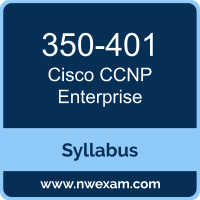 A great way to start the Cisco Certified Specialist Enterprise Core (ENCOR) preparation is to begin by properly appreciating the role that syllabus and study guide play in the Cisco 350-401 certification exam. This study guide is an instrument to get you on the same page with Cisco and understand the nature of the Cisco CCNP Enterprise exam.
A great way to start the Cisco Certified Specialist Enterprise Core (ENCOR) preparation is to begin by properly appreciating the role that syllabus and study guide play in the Cisco 350-401 certification exam. This study guide is an instrument to get you on the same page with Cisco and understand the nature of the Cisco CCNP Enterprise exam.
Our team of experts has composed this Cisco 350-401 exam preparation guide to provide the overview about Implementing and Operating Cisco Enterprise Network Core Technologies exam, study material, sample questions, practice exam and ways to interpret the exam objectives to help you assess your readiness for the Cisco ENCOR exam by identifying prerequisite areas of knowledge. We recommend you to refer the simulation questions and practice test listed in this guide to determine what type of questions will be asked and the level of difficulty that could be tested in the Cisco CCNP Enterprise certification exam.
Cisco 350-401 Exam Overview:
| Exam Name | Implementing and Operating Cisco Enterprise Network Core Technologies |
| Exam Number | 350-401 ENCOR |
| Exam Price | $400 USD |
| Duration | 120 minutes |
| Number of Questions | 90-110 |
| Passing Score | Variable (750-850 / 1000 Approx.) |
| Recommended Training |
Implementing and Operating Cisco Enterprise Network Core Technologies | ENCOR Implementing and Operating Cisco Enterprise Network Core Technologies 1.3 Implementing and Operating Cisco Enterprise Network Core Technologies (ENCOR) v1.3 |
| Exam Registration | PEARSON VUE |
| Sample Questions | Cisco 350-401 Sample Questions |
| Practice Exam | Cisco Certified Specialist Enterprise Core Practice Test |
Cisco 350-401 Exam Topics:
| Section | Weight | Objectives |
|---|---|---|
| Architecture | 15% |
- Explain the different design principles used in an enterprise network
- Describe wireless network design principles
- Explain the working principles of the Cisco SD-WAN solution
- Explain the working principles of the Cisco SD-Access solution
- Interpret wired and wireless QoS configurations
- Describe hardware and software switching mechanisms such as CEF, CAM, TCAM, FIB, RIB, and adjacency tables |
| Virtualization | 10% |
- Describe device virtualization technologies
- Configure and verify data path virtualization technologies
- Describe network virtualization concepts
|
| Infrastructure | 30% |
- Layer 2
- Layer 3
- Wireless
- IP Services
|
| Network Assurance | 10% |
- Diagnose network problems using tools such as debugs, conditional debugs, traceroute, ping, SNMP, and syslog - Configure and verify Flexible NetFlow - Configure SPAN/RSPAN/ERSPAN - Configure and verify IPSLA - Describe Cisco DNA Center workflows to apply network configuration, monitoring, and management - Configure and verify NETCONF and RESTCONF |
| Security | 20% |
- Configure and verify device access control
- Configure and verify infrastructure security features
- Describe REST API security
- Describe the components of network security design
|
| Automation | 15% |
- Interpret basic Python components and scripts - Construct valid JSON-encoded files - Describe the high-level principles and benefits of a data modeling language, such as YANG - Describe APIs for Cisco DNA Center and vManage - Interpret REST API response codes and results in payload using Cisco DNA Center and RESTCONF - Construct an EEM applet to automate configuration, troubleshooting, or data collection - Compare agent vs. agentless orchestration tools, such as Chef, Puppet, Ansible, and SaltStack |
Cisco ENCOR Exam Description:
Implementing Cisco Enterprise Network Core Technologies v1.1 (ENCOR 350-401) is a 120-minute exam associated with the CCNP and CCIE Enterprise Certifications. This exam tests a candidate's knowledge of implementing core enterprise network technologies, including dual stack (IPv4 and IPv6) architecture, virtualization, infrastructure, network assurance, security, and automation. The course Implementing Cisco Enterprise Network Core Technologies helps candidates to prepare for this exam.
